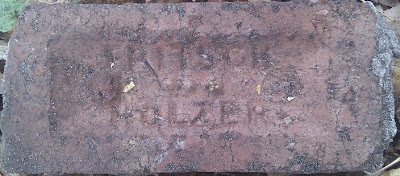In 1896, the Oakleigh Brick Company became
a member of the Co-operative Brick Company Limited This company was formed by
agreement between the Hoffman Patent Steam Brick Co., Northcote Brick Co. Ltd.,
New Northcote Brick Co. Ltd., Chas. Butler & Son and Fritsch, Holzer and
Co., and registered on 10 September 1896. Authorized capital was £50,000 in
50,000 shares of £1. The word ‘proprietary’ was added and registered on 11
February 1897. Authorized capital was increased to £150,000 on 17 July
1927. During its 70 years of business
the Oakleigh Brick Co., Clifton Brick Co., Blackburn Brick Co., City Brick Co.,
and the Standard Brick Co. (Box Hill) became associated. The company was taken over by Brick and Pipe
Industries Pty. Ltd., William Street, Melbourne, in 1966.
In
evidence before the Royal Commission, William Gardner Sprigg, Accountant said;
“It
was a matter of common knowledge that the brick
industry was in a very bad way. A large number
of kilns were closed, and those that were open were in competition so keen that most were losing money, and none was making a profit.
Various
persons in the industry had spoken to me as to whether something could not be done to remedy,
the evil. That
was early in 1895. Several meetings were held with a view to see whether the
live companies could not be made profitable by
amalgamation into
one. The
difficulties,
however, wore considerable, and that course was abandoned. Then at the
request of some of the directors I called the
representatives of the companies together to talk things over, and see if some feasible scheme could not
bo devised for remedying the evil state of affairs.
The
result was that it was agreed to form an association for regulating the price and output of bricks.
It was
then felt that some provision must be
made for the control of the large interests that at the time were in abeyance. Large companies had ceased work and were in the hands of financial institutions, and it was necessary, in order
to make a safe association
that some terms should be made whereby the closed yards and stagnant companies should get some return, and not be absolutely starved. Ultimately
I made terms with these idle companies through the banks, but it took many months, and it was not until the end of November
that the association
had completed such negotiations to enable it to carry on with safety.”
Holding Companies
A Holding Company or a Parent Company
are companies that own other
companies’ shares and usually refers to a company that does not produce
anything itself. Its purpose is to own
shares in other companies. It does not have any operations, activities,
or other active business; instead, it owns assets. Holding companies allow for the
reduction of risk for the owners
and can allow the ownership and control of a number of different companies.
The thing that makes a holding company is that it has no day-to-day
role in any of the companies, each is run by its own management team. In other
words, as a holding company, the job is executive oversight and or passive
investing, depending upon its’ corporate strategy. Its job is to put money to
work and determine if Company management is doing a good job. If it owns enough stock to control an
investment, it can fire the managers and replace them at its own discretion.
A Parent
Company is a company that owns
enough stock in another firm (a
subsidiary) to control management and operations by influencing or electing its
Board of Directors. Another benefit is
that if the Holding Company goes bust, it does not affect the companies owned
by them. This was seen in the 1990s
when a lot of long established English pottery companies were sold off (Usually
by management buyout) by their Holding Companies. Most are still doing well.
During the life of several of the brick works in Oakleigh, they were
owned by holding companies. For
example, some of these being;
The
Stamford Brick Company
Evans
Brothers Holdings Ltd
Glen
Iris Holdings
The
Co-operative Brick Company
Brick
and Pipe Industries
















































